

The next generation discovery citation indexes: a review of the landscape in 2020 (Aaron Tay) Think. Check. Submit. (Choose a trustworthy journal for your research.) All About Peer Review (CSUDH) This online activity will ask you to watch a short video and respond to discussion questions for All About Peer Review.
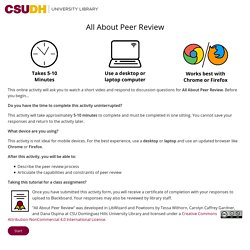
Before you begin... Do you have the time to complete this activity uninterrupted? This activity will take approximately 5-10 minutes to complete and must be completed in one sitting. You cannot save your responses and return to the activity later. *Microsoft Academic. *Semantic Scholar - An academic search engine for scientific articles. *BASE - Bielefeld Academic Search Engine. BASE is one of the world's most voluminous search engines especially for academic web resources.

BASE provides more than 200 million documents from more than 8,000 content providers. You can access the full texts of about 60% of the indexed documents for free (Open Access). BASE is operated by Bielefeld University Library. NIH Office of Portfolio Analysis. Cited-by. Researchers cite other people’s work to acknowledge the material they used when writing their own paper.
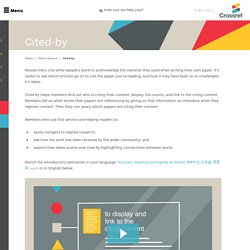
It’s useful to see which articles go on to cite the paper you’re reading, and how it may have built on or challenged it’s ideas. Cited-by helps members find out who is citing their content, display the counts, and link to the citing content. CiteSeerX. *PLOS One: accelerating the publication of peer-reviewed science. Get The Research. *Citation Performance Indicators - A Very Short Introduction. In June, Clarivate (formerly Thomson Reuters) will release the Journal Citation Report (JCR), an annual summary of the citation performances of more than ten thousand academic journals.
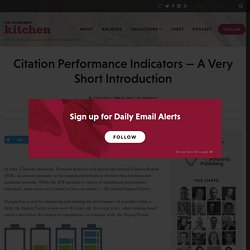
While the JCR includes a variety of benchmark performance indicators, most users are focused on just one metric — the Journal Impact Factor. Designed as a tool for measuring and ranking the performance of journals within a field, the Impact Factor is now over 40 years old. In recent years, other citation-based metrics have been developed to complement, or compete with, the Impact Factor. Figshare - credit for all your research. Dimensions. *The Networked Academic. ResearchGate - Share and discover research. *Scholarly Communications – Library 101 Toolkit. *Google Scholar: Library Partner or Database Competitor? By Nancy K.
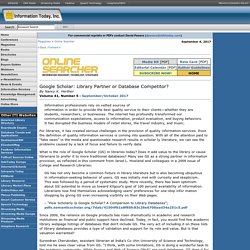
Herther Information professionals rely on vetted sources of information in order to provide the best quality service to their clients—whether they are students, researchers, or businesses. The internet has profoundly transformed our communication expectations, access to information, product evaluation, and buying behaviors. It has disrupted the business models of retail stores, the travel industry, and music. *UW iSchool Calling Bullshit 8.2: An Overview of Scholarly Publishing (*= Key reading)
Science News Cycle. Finding the Evidence 1 - Using PICO to formulate a search question. Arrowsmith two-node search interface: A tutorial on finding meaningful links between two disparate sets of articles in MEDLINE. Structured Abstracts. What are structured abstracts?
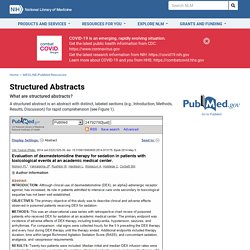
A structured abstract is an abstract with distinct, labeled sections (e.g., Introduction, Methods, Results, Discussion) for rapid comprehension (see Figure 1). Figure 1: PubMed Abstract Display for a Structured Abstract. What kinds of structures are used? Standardized formats for structured abstracts have been defined for original research studies, review articles and clinical practice guidelines (1,2).
The IMRAD format (INTRODUCTION, METHODS, RESULTS, and DISCUSSION), a defacto standard that reflects the process of scientific discovery (3), is commonly used as a structure for journal abstracts (4,5). Coalition for Diversity and Inclusion in Scholarly Communications. DORA – San Francisco Declaration on Research Assessment (DORA) For academics, what matters more: journal prestige or readership? With more than 30,000 academic journals now in circulation, academics can have a hard time figuring out where to submit their work for publication.
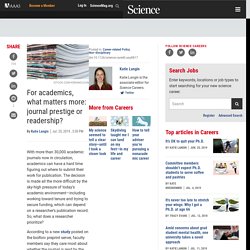
Eigenfactor® Score. Kudos – helping increase the reach and impact of research. Toolkits for Equity – Coalition for Diversity and Inclusion in Scholarly Communications. While a growing awareness of racial disparities has resulted in a groundswell of support for inclusivity in scholarly publishing, the resulting initiatives would be more effective if our professional associations were able to provide training materials to help transform our workplaces and organizational cultures.
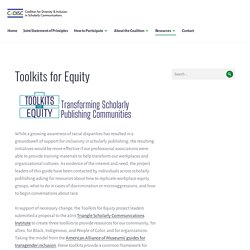
Journal Citation Reports. Academic Collections 2019 Final. Publish or Perish. Connecting Research and Researchers. Rutgers University Begins Implementation of ORCID iDs. Today, Rutgers University begins a formal universitywide implementation of Open Researcher & Contributor IDs (ORCID iDs).
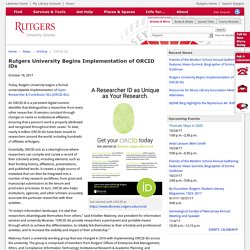
An ORCID iD is a persistent digital numeric identifier that distinguishes a researcher from every other researcher. It remains constant through changes in name or institutional affiliation, ensuring that a person’s work is properly attributed and recognized throughout their career. To date, nearly 4 million ORCID iDs have been issued to researchers around the world, including hundreds of affiliates at Rutgers.
Essentially, ORCID acts as a clearinghouse where researchers can compile and curate a record of their scholarly activity, including elements such as their funding history, affiliations, presentations, and published works. Science Conferences Are Stuck in the Dark Ages. Predatory journals: no definition, no defence. When ‘Jane’ turned to alternative medicine, she had already exhausted radiotherapy, chemotherapy and other standard treatments for breast cancer.
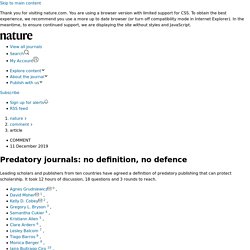
Her alternative-medicine practitioner shared an article about a therapy involving vitamin infusions. Beall's List of Predatory Journals and Publishers - Publishers. Two Competing Visions for Research Data Sharing. Scholarly publishing is broken. Here’s how to fix it. The world of scholarly communication is broken. Giant, corporate publishers with racketeering business practices and profit margins that exceed Apple’s treat life-saving research as a private commodity to be sold at exorbitant profits.
Only around 25 per cent of the global corpus of research knowledge is ‘open access’, or accessible to the public for free and without subscription, which is a real impediment to resolving major problems, such as the United Nations’ Sustainable Development Goals. Recently, Springer Nature, one of the largest academic publishers in the world, had to withdraw its European stock market floatation due to a lack of interest.
This announcement came just days after Couperin, a French consortium, cancelled its subscriptions to Springer Nature journals, after Swedish and German universities cancelled their Elsevier subscriptions to no ill effect, besides replenished library budgets. Scientific publishing needs to change. Wakefulness and Digitally Engaged Publics - Hybrid Pedagogy. Assembling the pieces of a systematic review : guide for librarians (Foster & Jewell ) Librarian co-authors correlated with higher quality reported search strategies in general internal medicine systematic reviews.
Guest Post: Is the Research Article Immune to Innovation? Scientific Search Engines Are Getting More Powerful. Nature vs. Science, pt. 2. Author-level metrics in the new academic profile platforms: The online behaviour of the Bibliometrics community. How can blogging help research make an impact beyond academia? Illustrative examples from the LSE blogs. Previous posts in our series on the Impact of LSE Blogs project examined the effects of blogging on the academic sphere, looking more closely at citations to the original research outputs and also to the blog posts themselves.
Mendeley - Reference Management Software & Researcher Network. The Duck Penis Paradox.